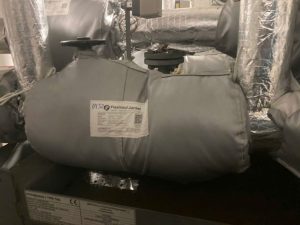How can you be sure that an insulation jacket will operate effectively and safely in harsh industrial environments? The answer lies in a strict quality control (QC) process before the product is shipped. This is an indispensable step to ensure every insulation jacket or blanket meets the correct technical standards, durability, and insulation capabilities, helping to optimize energy efficiency and protect the entire system’s safety.
Let’s explore the 5 core steps in this process in detail.
Why is Quality Inspection for Insulation Jackets Necessary?
Removable insulation jackets are a flexible solution for valves, pipes, joints, and machinery. A thorough quality check before delivery offers vital benefits:
- Ensure Promised Thermal Performance: The product must meet its designed specifications to reduce heat loss, save energy, and lower operating costs for the business.
- Ensure Operational Safety: Thorough inspection helps detect and eliminate potential defects like poor-quality materials or weak seams, which could lead to dangerous heat leaks.
- Increase Product Durability and Lifespan: A standard-compliant insulation jacket will have high mechanical strength and be resistant to environmental factors, thus reducing maintenance and replacement frequency.
- Affirm the Manufacturer’s Reputation: A professional QC process is the clearest evidence of the supplier’s capability and commitment to quality.
The Comprehensive 5-Step Insulation Jacket Inspection Process
A professional inspection process monitors quality from raw materials through to the finished and packaged product.
1. Incoming Material Inspection
The quality of the final product depends entirely on the quality of its raw materials. This is the most fundamental and crucial step.
- Outer Fabric: Detailed checks of Certificate of Origin (CO), Certificate of Quality (CQ), and technical specifications for heat resistance, water resistance, chemical resistance, and tensile strength.
- Insulation Material: Verify the correct type, thickness, density, heat resistance, and thermal conductivity. Common materials like ceramic fiber, glass wool, or aerogel must meet project standards.
- Accessories: All accessories such as heat-resistant thread (Kevlar thread, stainless steel thread), straps, buckles, and D-rings must be thoroughly inspected to ensure they can withstand tension, heat, and do not rust.
2. In-Process Inspection
Monitoring quality at each stage helps to detect and rectify errors immediately, preventing waste and ensuring consistency.
- Cutting Stage: Check the dimensions and shapes of the material pieces against the technical drawings. Even minor dimensional deviations can cause the insulation jacket to fit poorly, creating gaps that lead to heat loss.
- Sewing Stage: Supervise sewing techniques to ensure stitches are straight, even, strong, and free of skipped or loose threads, especially at load-bearing points like handles and seams.
3. Final Product Inspection
This is the final overall check before a product is approved.
- Overall Dimension Check: Use measuring tools to compare the length, width, and diameter of the insulation jacket with the design drawings, ensuring tolerances are within acceptable limits.
- Visual and Finishing Inspection:
- The product surface must be clean, with no tears, stains, or fraying.
- Seams must be sharp with no loose threads.
- Accessories like straps and buckles must be correctly positioned, operate smoothly, and be secure.
- Fit-up Test: Test-fit the insulation jacket on a model or the actual equipment (if possible). This step ensures the product fits snugly, covers the entire surface to be insulated, cutouts are accurately placed, and installation/removal is easy.
4. Functional Testing
Depending on the specific requirements of each project, functional tests may be performed to further verify durability.
- Tensile Strength Test: Use specialized equipment to test the tensile strength of straps and joints, ensuring they are strong enough to hold the insulation jacket securely during operation.
- Heat Resistance Test: In some cases, a sample product may be placed in an environment simulating operating temperatures to evaluate the durability of its materials and structure.
5. Pre-Packaging and Shipping Inspection
The final step ensures the product reaches the customer in perfect condition and with complete information.
- Tagging: Each product must be labeled with its model number, equipment name, operating temperature, and other important information to facilitate easy identification and installation.
- Packaging Check: The product is carefully packed in suitable packaging to protect against moisture, dust, and physical damage during transit.
- Finalize Quality Documentation: Prepare a Quality Inspection Report for the shipment, fully documenting the results of all inspection steps to serve as a basis for acceptance.
A rigorous inspection process is the strongest commitment to a quality, safe, and effective insulation jacket, providing absolute peace of mind for the customer.
Request consultation and quotation now!Frequently Asked Questions
What materials are typically used for insulation jackets?
Insulation jackets typically have a 3-layer construction: a weather-resistant outer fabric (Silicone, Teflon), an insulation material in the middle (ceramic fiber, glass wool, aerogel), and an inner lining fabric. Accessories like thread and straps must also be made from heat-resistant materials.
How can you check if an insulation jacket fits properly?
The best way is to perform a Fit-up Test directly on the equipment or a model of equivalent size. A standard-compliant jacket must fit snugly against the surface, without large gaps, and any cutouts must be accurately placed.
What are the most common defects in low-quality insulation jackets?
Common defects include incorrect dimensions, weak or uneven seams, use of the wrong insulation material, easily torn outer fabric, and non-durable accessories like buckles and straps.
Why is it necessary to use heat-resistant thread like Kevlar for sewing insulation jackets?
Conventional sewing thread will decompose or break at high temperatures, causing the entire jacket structure to fall apart. Specialized heat-resistant thread like Kevlar or stainless steel ensures that the seams remain durable in harsh working environments.










